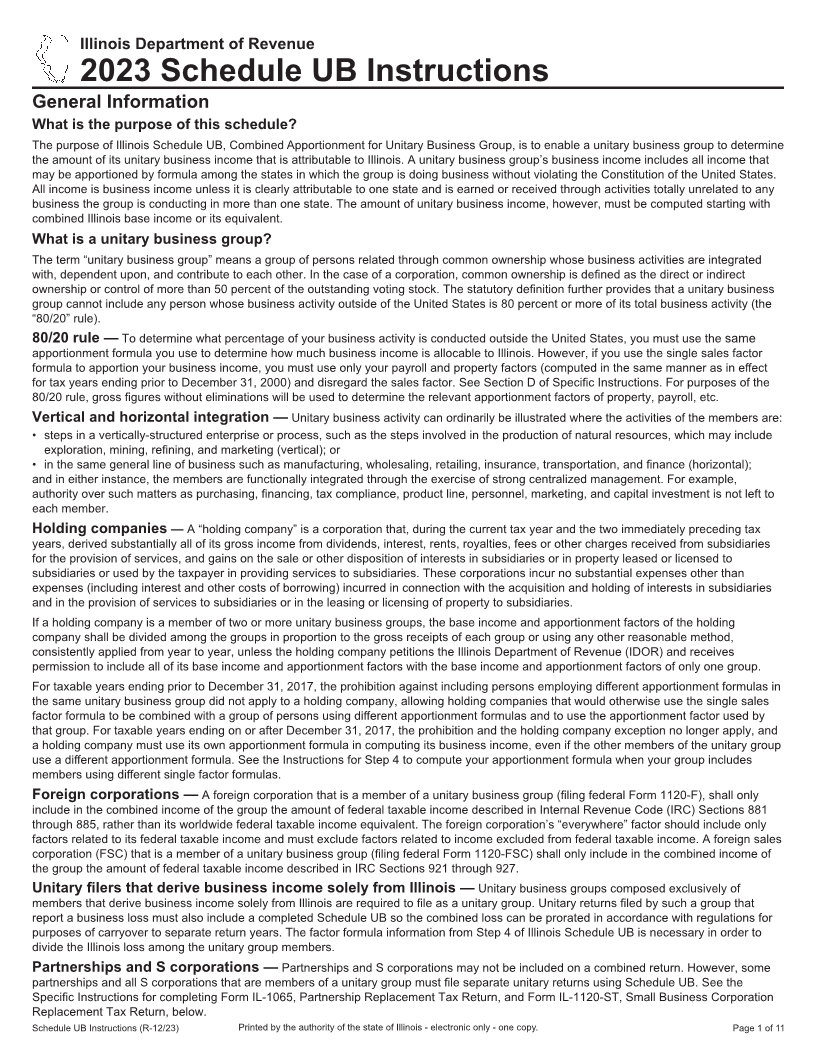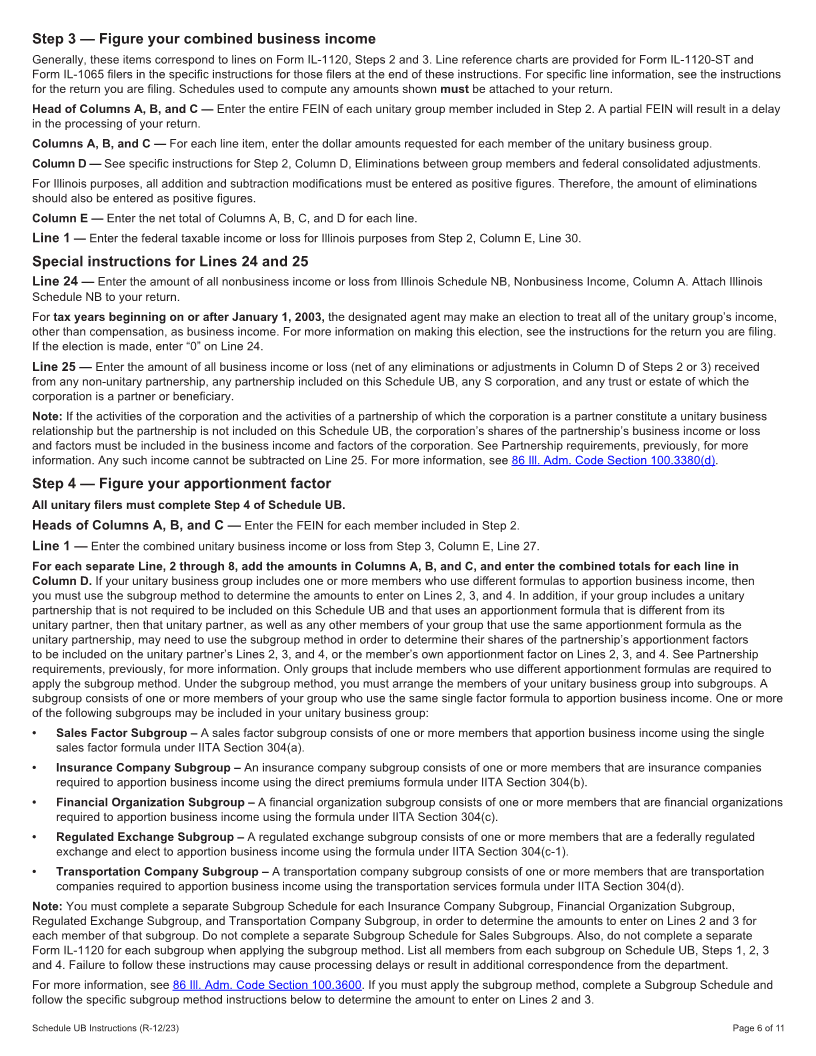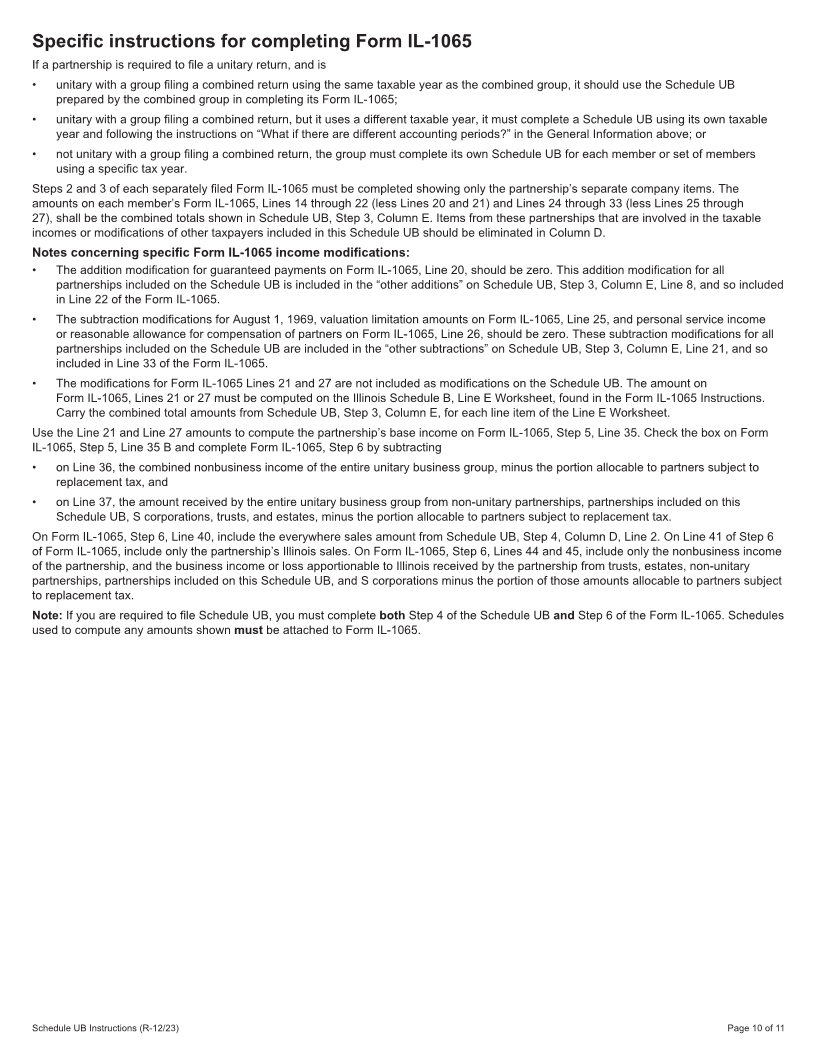
Enlarge image
Illinois Department of Revenue 2023 Schedule UB Instructions General Information What is the purpose of this schedule? The purpose of Illinois Schedule UB, Combined Apportionment for Unitary Business Group, is to enable a unitary business group to determine the amount of its unitary business income that is attributable to Illinois. A unitary business group’s business income includes all income that may be apportioned by formula among the states in which the group is doing business without violating the Constitution of the United States. All income is business income unless it is clearly attributable to one state and is earned or received through activities totally unrelated to any business the group is conducting in more than one state. The amount of unitary business income, however, must be computed starting with combined Illinois base income or its equivalent. What is a unitary business group? The term “unitary business group” means a group of persons related through common ownership whose business activities are integrated with, dependent upon, and contribute to each other. In the case of a corporation, common ownership is defined as the direct or indirect ownership or control of more than 50 percent of the outstanding voting stock. The statutory definition further provides that a unitary business group cannot include any person whose business activity outside of the United States is 80 percent or more of its total business activity (the “80/20” rule). 80/20 rule — To determine what percentage of your business activity is conducted outside the United States, you must use the same apportionment formula you use to determine how much business income is allocable to Illinois. However, if you use the single sales factor formula to apportion your business income, you must use only your payroll and property factors (computed in the same manner as in effect for tax years ending prior to December 31, 2000) and disregard the sales factor. See Section D of Specific Instructions. For purposes of the 80/20 rule, gross figures without eliminations will be used to determine the relevant apportionment factors of property, payroll, etc. Vertical and horizontal integration — Unitary business activity can ordinarily be illustrated where the activities of the members are: • steps in a vertically-structured enterprise or process, such as the steps involved in the production of natural resources, which may include exploration, mining, refining, and marketing (vertical); or • in the same general line of business such as manufacturing, wholesaling, retailing, insurance, transportation, and finance (horizontal); and in either instance, the members are functionally integrated through the exercise of strong centralized management. For example, authority over such matters as purchasing, financing, tax compliance, product line, personnel, marketing, and capital investment is not left to each member. Holding companies — A “holding company” is a corporation that, during the current tax year and the two immediately preceding tax years, derived substantially all of its gross income from dividends, interest, rents, royalties, fees or other charges received from subsidiaries for the provision of services, and gains on the sale or other disposition of interests in subsidiaries or in property leased or licensed to subsidiaries or used by the taxpayer in providing services to subsidiaries. These corporations incur no substantial expenses other than expenses (including interest and other costs of borrowing) incurred in connection with the acquisition and holding of interests in subsidiaries and in the provision of services to subsidiaries or in the leasing or licensing of property to subsidiaries. If a holding company is a member of two or more unitary business groups, the base income and apportionment factors of the holding company shall be divided among the groups in proportion to the gross receipts of each group or using any other reasonable method, consistently applied from year to year, unless the holding company petitions the Illinois Department of Revenue (IDOR) and receives permission to include all of its base income and apportionment factors with the base income and apportionment factors of only one group. For taxable years ending prior to December 31, 2017, the prohibition against including persons employing different apportionment formulas in the same unitary business group did not apply to a holding company, allowing holding companies that would otherwise use the single sales factor formula to be combined with a group of persons using different apportionment formulas and to use the apportionment factor used by that group. For taxable years ending on or after December 31, 2017, the prohibition and the holding company exception no longer apply, and a holding company must use its own apportionment formula in computing its business income, even if the other members of the unitary group use a different apportionment formula. See the Instructions for Step 4 to compute your apportionment formula when your group includes members using different single factor formulas. Foreign corporations — A foreign corporation that is a member of a unitary business group (filing federal Form 1120-F), shall only include in the combined income of the group the amount of federal taxable income described in Internal Revenue Code (IRC) Sections 881 through 885, rather than its worldwide federal taxable income equivalent. The foreign corporation’s “everywhere” factor should include only factors related to its federal taxable income and must exclude factors related to income excluded from federal taxable income. A foreign sales corporation (FSC) that is a member of a unitary business group (filing federal Form 1120-FSC) shall only include in the combined income of the group the amount of federal taxable income described in IRC Sections 921 through 927. Unitary filers that derive business income solely from Illinois — Unitary business groups composed exclusively of members that derive business income solely from Illinois are required to file as a unitary group. Unitary returns filed by such a group that report a business loss must also include a completed Schedule UB so the combined loss can be prorated in accordance with regulations for purposes of carryover to separate return years. The factor formula information from Step 4 of Illinois Schedule UB is necessary in order to divide the Illinois loss among the unitary group members. Partnerships and S corporations — Partnerships and S corporations may not be included on a combined return. However, some partnerships and all S corporations that are members of a unitary group must file separate unitary returns using Schedule UB. See the Specific Instructions for completing Form IL-1065, Partnership Replacement Tax Return, and Form IL-1120-ST, Small Business Corporation Replacement Tax Return, below. Schedule UB Instructions (R-12/23) Printed by the authority of the state of Illinois - electronic only - one copy. Page 1 of 11









